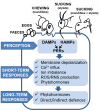Plant Perception and Short-Term Responses to Phytophagous Insects and Mites
- PMID: 29751577
- PMCID: PMC5983831
- DOI: 10.3390/ijms19051356
Plant Perception and Short-Term Responses to Phytophagous Insects and Mites
Abstract
Plant⁻pest relationships involve complex processes encompassing a network of molecules, signals, and regulators for overcoming defenses they develop against each other. Phytophagous arthropods identify plants mainly as a source of food. In turn, plants develop a variety of strategies to avoid damage and survive. The success of plant defenses depends on rapid and specific recognition of the phytophagous threat. Subsequently, plants trigger a cascade of short-term responses that eventually result in the production of a wide range of compounds with defense properties. This review deals with the main features involved in the interaction between plants and phytophagous insects and acari, focusing on early responses from the plant side. A general landscape of the diverse strategies employed by plants within the first hours after pest perception to block the capability of phytophagous insects to develop mechanisms of resistance is presented, with the potential of providing alternatives for pest control.
Keywords: acari; early signaling; effectors; elicitors; insect; phytophagous arthropods; plant defenses; plant receptors.
Conflict of interest statement
The authors declare no conflict of interest.
Figures



References
-
- Ortego F. Arthropod-plant Interactions. Springer; Dordrecht, The Netherlands: Hidelberg, Germany: New York, NY, USA: London, UK: 2012. Physiological adaptation of the insect gut to herbivory; pp. 75–88.
-
- Bensoussan N., Santamaria M.E., Zhurov V., Diaz I., Grbic M., Grbic V. Plant-herbivore interaction: Dissection of the cellular pattern of Tetranychus urticae: Toward understanding cell biology of plant-pest interaction. Front. Plant Sci. 2016;7:1105. doi: 10.3389/fpls.2016.01105. - DOI - PMC - PubMed
Publication types
MeSH terms
Substances
LinkOut - more resources
Full Text Sources
Other Literature Sources

